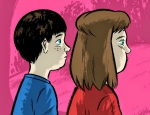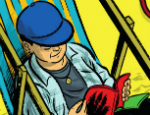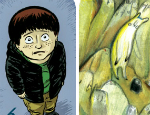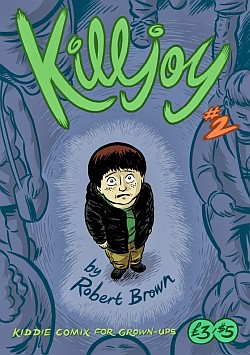 This second issue of Robert Brown’s comic strip reminiscences has been a while in coming but those who found his wistful recollections of his younger days in #1 so evocative of their own childhoods will not be disappointed with Killjoy #2. This short compilation of anecdotes is also replete with moments to nod your head knowingly at, as you recall similar incidents to those Brown depicts from your mistily remembered school days.
This second issue of Robert Brown’s comic strip reminiscences has been a while in coming but those who found his wistful recollections of his younger days in #1 so evocative of their own childhoods will not be disappointed with Killjoy #2. This short compilation of anecdotes is also replete with moments to nod your head knowingly at, as you recall similar incidents to those Brown depicts from your mistily remembered school days.
It’s been almost two years to the day since I reviewed the first issue of Killjoy – that opening edition concerning itself with the rituals and eccentricities surrounding a weekend at scout camp. Killjoy #2 focuses largely on an apparently younger Brown than the one we were introduced to in #1, presenting a number of vignettes comprising scattered moments from his early years rather than one longer form story.
What’s beautifully captured throughout #2 is not just that child’s eye perspective on the world but also how instantly recognisable the events of each tale are. In the first story ‘Le Secret de Laura’ we witness a traumatic school day for Robert when his long-held belief that he is “in love” with his friend Laura is revealed to said object of affection. The sense of excruciating humiliation is palpable here; that almost debilitating feeling of mortification that only the politics of the playground can deliver.
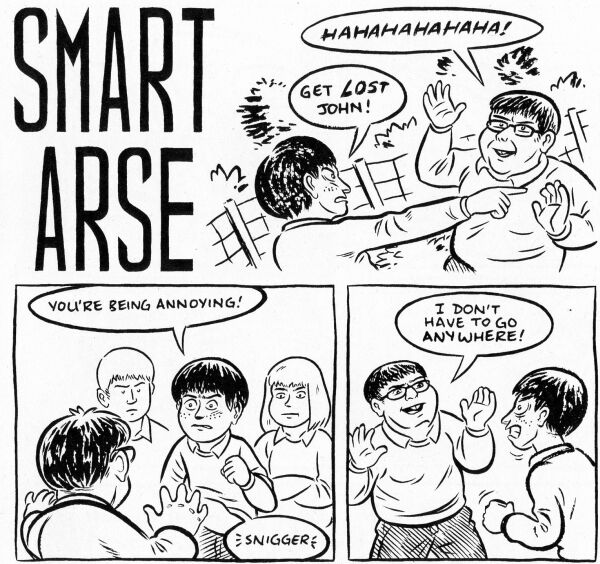 ‘Smart Arse’ (above) allows us to observe a case of natural if uncomfortable justice in the schoolyard as a classmate nuisance gets his comeuppance in admittedly rather unfair circumstances, and ‘Ex Corpus’ is a nostalgic reminder of the ridiculous urban myths that would circulate when we were kids without any challenge to their credibility being raised.
‘Smart Arse’ (above) allows us to observe a case of natural if uncomfortable justice in the schoolyard as a classmate nuisance gets his comeuppance in admittedly rather unfair circumstances, and ‘Ex Corpus’ is a nostalgic reminder of the ridiculous urban myths that would circulate when we were kids without any challenge to their credibility being raised.
The last two entries in Killjoy #2 were probably my favourites this time round. In ‘Watershed’ we join our hero and his brother on their nocturnal mission to watch Beavis and Butthead after their parents have gone to bed (below). It’s a clandestine operation to partake in the parentally forbidden that I think will resonate with many readers. Finally, ‘Lost and Found’ perfectly brings to life the resulting terror of being separated as a child from your parents in a public place.
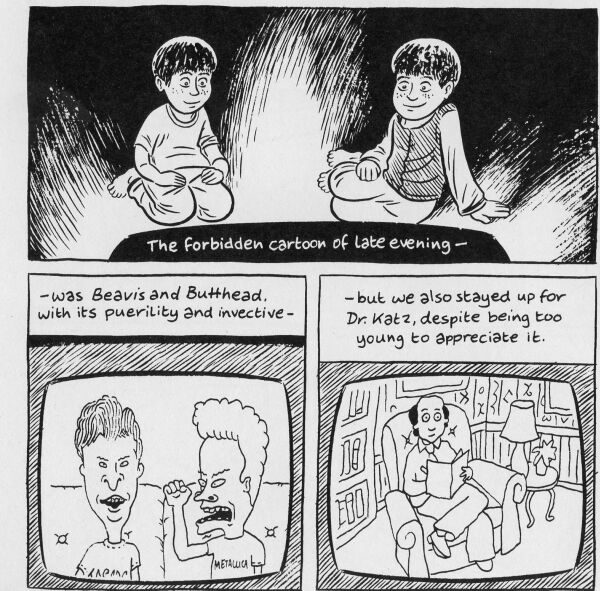 What’s interesting about Brown’s storytelling here is that he places the reader in the role of external observer of events rather than directly elaborating on them through any introspective narration from his past self; the reader plays a more passive role in the narrative, always slightly detached from the action. It’s a technique that puts a greater emphasis on Brown’s depiction of his characters’ facial expressions and body language to express emotion and motivation. His cartooning is always up to the task, though, from his visual portrayal of his younger self’s shame in ‘Le Secret de Laura’ (below) which makes the reader cringe in sympathy, to that amazingly evocative moment in ‘Lost and Found’ when a bewildered Robert stares up into a sea of adults realising he is alone without his father to turn to (as portrayed on #3’s cover).
What’s interesting about Brown’s storytelling here is that he places the reader in the role of external observer of events rather than directly elaborating on them through any introspective narration from his past self; the reader plays a more passive role in the narrative, always slightly detached from the action. It’s a technique that puts a greater emphasis on Brown’s depiction of his characters’ facial expressions and body language to express emotion and motivation. His cartooning is always up to the task, though, from his visual portrayal of his younger self’s shame in ‘Le Secret de Laura’ (below) which makes the reader cringe in sympathy, to that amazingly evocative moment in ‘Lost and Found’ when a bewildered Robert stares up into a sea of adults realising he is alone without his father to turn to (as portrayed on #3’s cover).
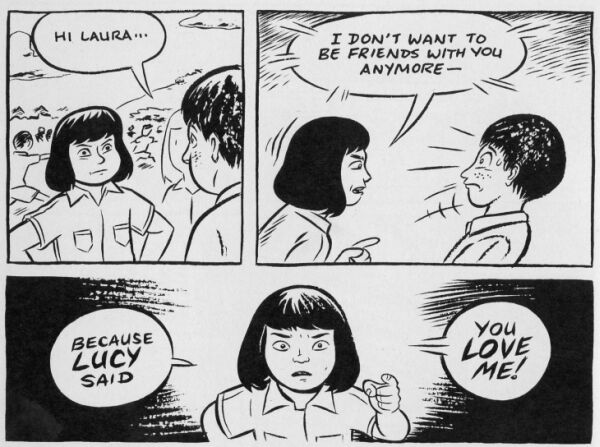 Killjoy is slice-of-life comics at their purest – it’s all a little Pekar-esque in that regard – and I am sure there will be those who will find it too slight in structure, too inconsequential in narrative thrust, to satisfy them. Killjoy isn’t about elaborating on a good story to dress it up into something grander, though, or about building up to a witty punchline. It’s concerned simply with earnest, straightforward anecdotal re-creation, and in this respect Brown consistently captures these isolated episodes from his past as identifiable and common experiences his readership can empathise with. A gentle masterclass in how to fully immerse your audience in the moment.
Killjoy is slice-of-life comics at their purest – it’s all a little Pekar-esque in that regard – and I am sure there will be those who will find it too slight in structure, too inconsequential in narrative thrust, to satisfy them. Killjoy isn’t about elaborating on a good story to dress it up into something grander, though, or about building up to a witty punchline. It’s concerned simply with earnest, straightforward anecdotal re-creation, and in this respect Brown consistently captures these isolated episodes from his past as identifiable and common experiences his readership can empathise with. A gentle masterclass in how to fully immerse your audience in the moment.
For more on Robert Brown’s work check out his site here. Killjoy can be bought from his online store here priced £3.00.





